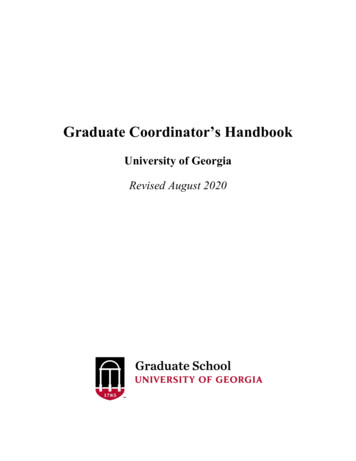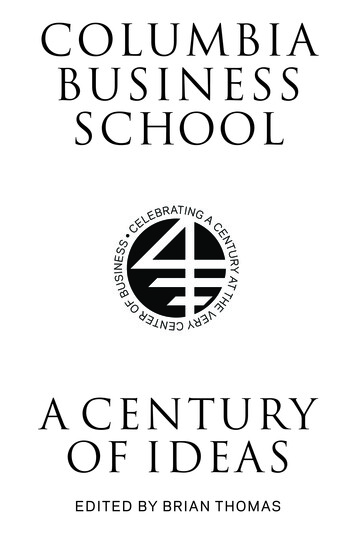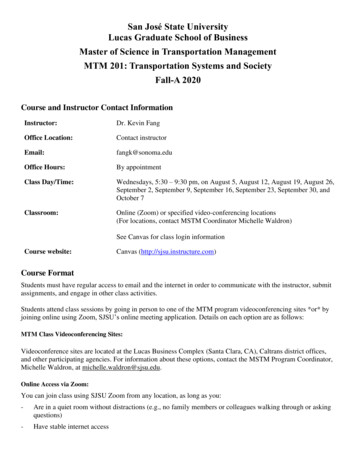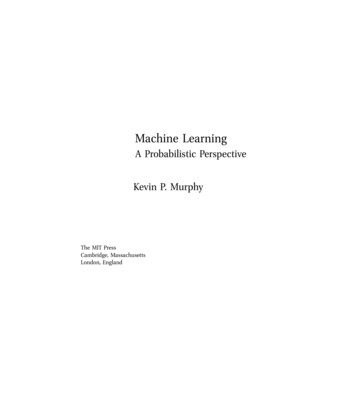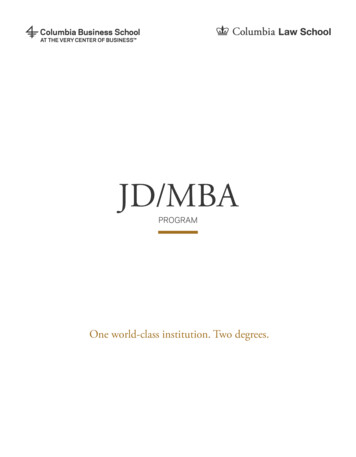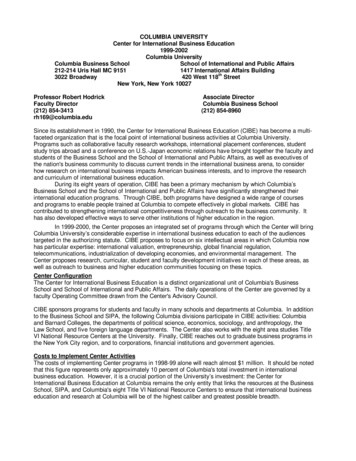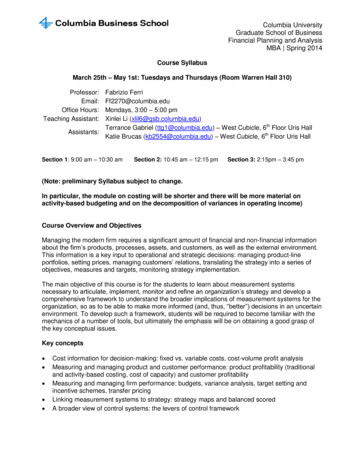
Transcription
Columbia UniversityGraduate School of BusinessFinancial Planning and AnalysisMBA Spring 2014Course SyllabusMarch 25th – May 1st: Tuesdays and Thursdays (Room Warren Hall 310)Professor:Email:Office Hours:Teaching Assistant:Fabrizio FerriFf2270@columbia.eduMondays, 3:00 – 5:00 pmXinlei Li (xlil6@gsb.columbia.edu)Terrance Gabriel (ttg1@columbia.edu) – West Cubicle, 6th Floor Uris HallAssistants:Katie Brucas (kb2554@columbia.edu) – West Cubicle, 6th Floor Uris HallSection 1: 9:00 am – 10:30 amSection 2: 10:45 am – 12:15 pmSection 3: 2:15pm – 3:45 pm(Note: preliminary Syllabus subject to change.In particular, the module on costing will be shorter and there will be more material onactivity-based budgeting and on the decomposition of variances in operating income)Course Overview and ObjectivesManaging the modern firm requires a significant amount of financial and non-financial informationabout the firm’s products, processes, assets, and customers, as well as the external environment.This information is a key input to operational and strategic decisions: managing product-lineportfolios, setting prices, managing customers’ relations, translating the strategy into a series ofobjectives, measures and targets, monitoring strategy implementation.The main objective of this course is for the students to learn about measurement systemsnecessary to articulate, implement, monitor and refine an organization’s strategy and develop acomprehensive framework to understand the broader implications of measurement systems for theorganization, so as to be able to make more informed (and, thus, “better”) decisions in an uncertainenvironment. To develop such a framework, students will be required to become familiar with themechanics of a number of tools, but ultimately the emphasis will be on obtaining a good grasp ofthe key conceptual issues.Key concepts Cost information for decision-making: fixed vs. variable costs, cost-volume profit analysisMeasuring and managing product and customer performance: product profitability (traditionaland activity-based costing, cost of capacity) and customer profitabilityMeasuring and managing firm performance: budgets, variance analysis, target setting andincentive schemes, transfer pricingLinking measurement systems to strategy: strategy maps and balanced scoredA broader view of control systems: the levers of control framework
Class MeetingsClass time will primarily be a mix of lectures and case analysis. I believe that an interactive learningenvironment and a focus on real-world experiences allow for a deeper understanding ofmanagement accounting issues and result in greater appreciation of their importance in thebroader context of complex organizations. Hence, the main focus is on case discussion. For casediscussion to be effective, it is crucial that students will be active participants in class, providingcritical analyses of key issues and debating alternative courses of action. In turn, this requirescareful preparation of the case and other assigned readings before class. I will randomly call onstudents when discussing cases and students should be ready to present their analyses orcomment on others' analyses. To help in preparing the cases, I will assign a set of detailedguiding questions for each case. In my experience, preparing cases in teams is very productive.Thus, you are encouraged to do so. I prefer students not to use laptops in class.Teaching MaterialsReading material is in the course packet. Class handouts will be distributed before each class.Optional textbook (available on reserve at the library) is Horngren, Datar and Rajan (HDR) CostAccounting, a Managerial Emphasis, Fourteenth Edition.Website with course informationYou may access the course website through the CANVAS system.GradingThe course grade will be determined as follows: Participation15% Assignments (best 2 out of 3)15% Final Exam70%Final Exam: The final exam will be in-class, closed-book. You may use a double sided sheet ofnotes (typed or hand written). You must bring a calculator (computers not allowed). Please use apen (NOT a pencil).The final exam is currently scheduled for Date and Time TBA.Assignments: There will be 3 graded Assignments (Type C) due on April 1, April 15 and April 29,by 4:00pm. You will be required to upload them via Canvas. The 15% grade will be based on thebest two of the three assignments.Class participation: The grade for class participation will depend on the quality of your interactionand participation in class discussions.Final grade appeals must be made in writing.Honor CodeStudents are expected to adhere to Columbia Business School’s Code of Ethical and ProfessionalConduct and Integrity Code (the code). Failure to comply with the code may affect either yourgrade in the course or your standing in the Columbia Business School community or both.TypeDesignationDiscussion ofConceptsCIndividual/IndividualNone of any kindFinancial Planning and AnalysisPreparation ofSubmissionIndividually (Nosharing of anyportion of thesubmission.)GradeIndividualPage 2
Course Calendar At-A-GlanceDateMarch 25SessionTopic1Course Introduction. Variable vs fixed costs: usingCVP analysis for decision making:Case to prepareMeasuring and managing the performance ofyour products and customersMarch 272April 1April 3April 8April 103456What is the cost of a product? Allocating indirectcostsMeasuring and managing the cost of capacity.Seligram ETOActivity-based costingWilkersonBeyond products: customer profitabilityKanthal, Ethical DrugsNew trends in ABC. Introduction of next module.Measuring and managing firm performanceApril 15April 17April 22April 2478910Budgeting and variance analysis IBudgeting and variance analysis IIMusimundoTransfer PricingBirch PaperTarget setting and incentives: the EVA solutionVyaderm PharmaceuticalsThe link to strategyApril 2911May 112TBAFinal ExamTranslating and testing the strategy: strategy mapsand balanced scorecardThe levers of controlFinancial Planning and AnalysisTransworld Auto Parts(A),Store 24ATH Microtechnologies(A,B)Page 3
Course OutlineSession 1 Management Accounting as Management SystemTuesday, March 25Introduction to cost concepts and applicationsTopics Readings PreparePracticeProblemsManagement accounting as management system: the link to strategyCost concepts: variable and fixed costs, direct and indirect costsUsing cost concepts for decision-making: cost-volume profit analysis“Mastering the Management System” (course packet)Optional reading from HDR: Ch.2 pp.26-38 (cost concepts); Ch.3 pp.62-82(cost-volume-profit analysis)Read article “Mastering the Management System” (course packet).Practice problems: HDR 2-18, 2-19, 2-20, 2-23. HDR 3-19, 3-24, 3-25.Problems and solutions are posted online. You can practice these problems afterclass.After presenting objectives and structure of the course, we will introduce somekey cost concepts that will be used throughout the course: direct and indirectcosts, variable and fixed costs.SessionPlanThe distinction between variable and fixed costs allows us to use the so-calledcost-volume-profit (CVP) analysis – a set of tools that exploits the relationbetween cost, prices and volume for decision-making purposes. We will discuss anumber of key concepts – contribution margin, break-even point and operatingleverage –, identify some formulas that can be used to measure these constructsand review a number of applications. We will then review the assumptionsunderlying CVP analysis and examine its limitations.Financial Planning and AnalysisPage 4
Measuring and managing the performance of your products and customersSession 2TopicsReadingsPrepareSessionPlanWhat is the cost of a product? Allocatingindirect costs Tuesday, March 27Mechanics of two-stage allocations: cost pools and cost drivers.Limits of “traditional” costing systems.Information vs incentives: dual role of costing systems Case study Seligram, Inc.: Electronic Testing Operations in the course packetOptional reading from HDR: Ch.2 pp.27-30 (definition of direct and indirectcosts) and pp.36-38 (classification of manufacturing costs)Read assigned case and address the following questions:1. What is the problem with the existing costing system at ETO?2. Calculate the reported costs of the five components described in the case(Exhibit 6) under:1. the existing system;2. the system proposed by the accounting manager;3. the system proposed by the consultant.3. Which system is preferable? Why?4. Consider the new machine described at the end of the case. Would you treatthe new machine as a separate cost center or as part of the main test room?Why? (answer this question qualitatively, ignore the issue of how to quantifythe cost of the new machine)We will devote the session to discussing the Seligram case.The case gives us an opportunity to appreciate the need for proper costallocations, understand the mechanics of two-stage allocations and the effect ofadding cost pools and changing cost drivers. We will also examine the limits ofthis type of volume-based cost allocationsFinancial Planning and AnalysisPage 5
Session 3Measuring and managing the cost of capacityTopics Dealing with the cost of capacity in a costing system.Readings Autobest Products (course packet).Microgene (course packetTuesday, April 1First, read the Autobest Products exercise and answer the questions at the end ofthe exercise.Second, read the Microgene short case and address the following questions:Prepare1. The gross margins of cartridges in the 2009 Revised Budget are dramaticallydifferent from the original 2009 Budget. Why?2. Can you show how the overhead costs of 26 and 50 are computed?3. Is this costing system providing useful information? If not, how can it bemodified?Finally, back to the case study Seligram, Inc.: Electronic Testing Operations in thecourse packet. Address the following question:1. Assume we treat the overhead cost associated with the new machine at theend of the case as a separate cost pool (see previous class). How would yougo about computing the overhead rate for this cost pool?SessionPlanWe will spend the first part of the class on the Autobest Products exercise. Then,we will discuss the Microgene case, focusing on the questions above. Finally, wewill spend the remaining time re-examining the problem of the new machine in theSeligram case.The three settings have in common the problem of how to treat the cost ofcapacity in the context of a two-stage cost allocation system.Financial Planning and AnalysisPage 6
Session 4Activity-based costingThursday, April 3Topics Activity-based costing.Differences from and advantages over “traditional” costing systems.Translating activity-based costing into improved profitability.Readings “Introduction to Activity-Based Costing” (course packet)Case study Wilkerson Company in the course packetAfter reading the Wilkerson case, answer the following questions:PrepareSessionPlan1. Using a two-stage cost-allocation diagram, describe Wilkerson’ existing costsystem and the alternative activity-based costing (ABC) system.2. Compute the profitability of Wilkerson’s three product lines under the ABCsystem and compare it with the existing system. What causes the differences?3. Based on the ABC analysis, what actions could Wilkerson’s managementteam consider to improve the company’s profitability?We will discuss the Wilkerson case as an example of activity-based costing (ABC)and activity-based management (ABM). We will examine the advantages of ABCover traditional systems and discuss its implementation challenges.Financial Planning and AnalysisPage 7
Session 5Beyond Products: Customer ProfitabilityThursday, April 8Topics Use of ABC to measure customer profitabilityUsing customer profitability for decision-makingReview of allocation of indirect costsReadings “Measuring and Managing Customer Profitability” (course packet)Kanthal case (course packet)Ethical Drugs (course packet)Read the Ethical Drugs case (A) and (B) and answer the questions in the casePrepareRead the Kanthal case, but do not worry about the numbers and just try tounderstand why they introduced the new system (Kanthal 90 AccountManagement System) and what they are learning with it.Also, what would you do with the two large unprofitable customers revealed bythe new system?SessionPlanOften some overhead costs are incurred to serve customers and satisfy theirrequirements. This is particularly true for non-manufacturing costs, such as thecosts often lumped in financial reports as “sales, general and administrative”costs (SG&A). When firms are managed around customers’ needs, the costingsystem should be modified accordingly. Kanthal is an example of a companythat dramatically changed its operations after designing its cost systems aroundits customers and developing proper measures of customer profitability.Financial Planning and AnalysisPage 8
Session 6TopicsSessionPlan New trends in ABCThursday, April 10ABC Implementation challengesNew trends in ABC techniquesIn this session we will discuss implementation challenges that arise when firmsadopt an ABC system and discuss how they are addressed in a recent developmentcalled “time-driven” ABC.At the end of class, we will briefly review what learned in sessions 2-5 aboutallocation of indirect costs and introduce the second half of the courseFinancial Planning and AnalysisPage 9
Session 7Budgeting and Variance Analysis IThursday, April 15Topics ReadingsRead the short case “Dummy jeans” (course packet)(Optional); HFR pp.182-187, 199-201, 226-240PrepareRead the short case “Dummy jeans” (course packet) and answer the question atthe end of the caseSessionPlanIn this session we introduce the role of budgets as control mechanism andexamine a performance measurement tool called variance analysis – that is theanalysis of deviations from a pre-established target.We will use the short case Dummy jeans as an illustration of some of the varianceanalysis formulas
Columbia University Graduate School of Business Financial Planning and Analysis MBA Spring 2014 Course Syllabus . Managing the modern firm requires a significant amount of financial and non-financial information about the firm’s products, processes, assets, and customers, as well as the external environment. This information is a key input to operational and strategic decisions: managing .
